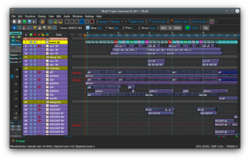MusE
Topic: Software
 From HandWiki - Reading time: 2 min
From HandWiki - Reading time: 2 min
 | |
 Screenshot of MusE 4.0 | |
| Original author(s) | Werner Schweer |
|---|---|
| Developer(s) | MusE development team |
| Initial release | 13 January 2000 |
| Stable release | 4.2.1
/ 24 September 2023 |
| Written in | C++, Qt |
| Operating system | Linux |
| Type | Digital audio workstation |
| License | GPL-2.0-or-later[1] |
| Website | muse-sequencer |
MusE is computer software, a sequencer for Musical Instrument Digital Interface (MIDI) and audio, with recording and editing abilities.[2][3][4] It was originally written by Werner Schweer and now is developed by the MusE development team. It is free software released under GPL-2.0-or-later.
MusE aims to be a complete multitrack virtual studio for Linux. As of 2020, it has no support under other platforms as it relies on Linux-only technologies, such as Advanced Linux Sound Architecture (ALSA). It also supports the Linux Audio Session Handler (LASH).
For version 0.7, the music notation feature was removed from MusE; this code later became the cross-platform notation app MuseScore.[5] A scoring feature returned to MusE in version 2.0.[6]
From version 2.2 MusE supports the LV2 audio plugin format and the formerly supported Linux Audio Developer's Simple Plugin API (LADSPA), Disposable Soft Synth Interface (DSSI), and Virtual Studio Technology (VST).
From version 4.0 a redesigned user interface has been added.
References
- ↑ MusE License
- ↑ Neumann, Frank (December 2003). "The MusE Audio/MIDI Sequencer: Professional Music Maker". Linux Magazine (Germany: Medialinx AG, Linux New Media) (37). http://www.linux-magazine.com/issue/37/MusE_Sequencer.pdf.
- ↑ Phillips, Dave. "Recording A MIDI Sequence With MusE". Dave Phillips. http://linux-sound.org/quick-toots/2-muse/quick-toot-muse.html.
- ↑ Barknecht, Frank. "HowTo Use MIDI Sequencers With Softsynths". Dave Phillips. http://linux-sound.org/quick-toots/4-sequencers_and_softsynths/quick-toot-midisynth_howto.html.
- ↑ Dave Phillips (Nov 23, 2004). "Linux MIDI: A Brief Survey, Part 2". Linux Journal. http://www.linuxjournal.com/article/7912. Retrieved 2011-12-29.
- ↑ github.com/muse-sequencer/muse/blob/master/src/ChangeLog "0.7.0pre4 tagged" .. "removed obsolete score editor" and "27.04.2011" ... "merged score edit branch into trunk (flo)"
External links
 |
 KSF
KSF